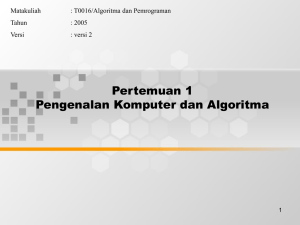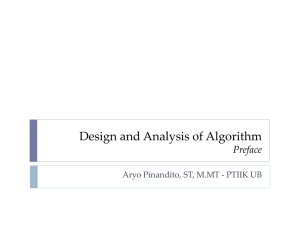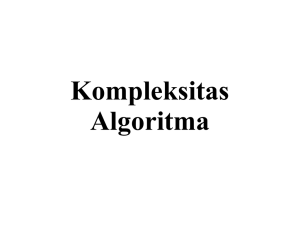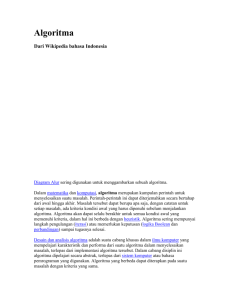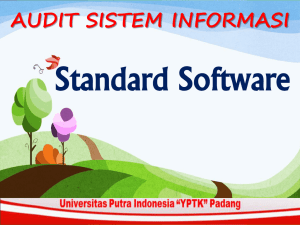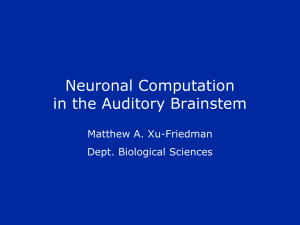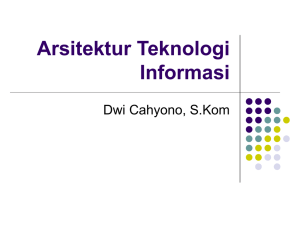DAA
advertisement
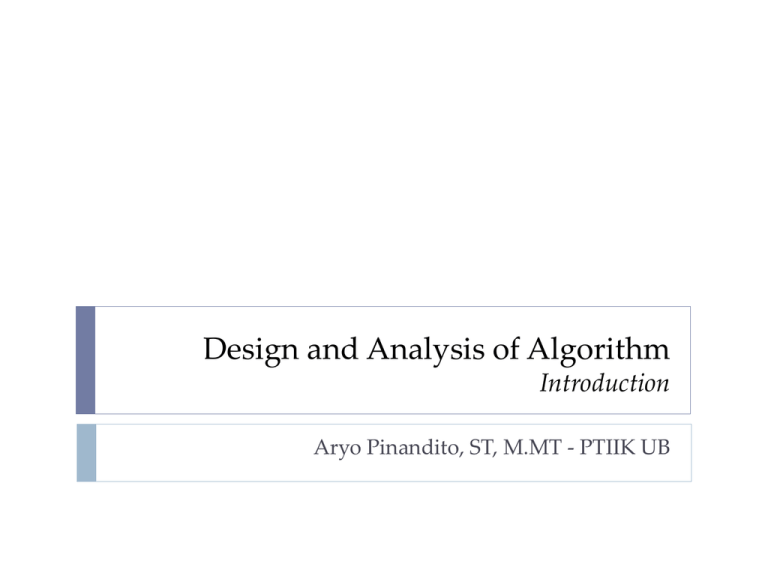
Design and Analysis of Algorithm Introduction Aryo Pinandito, ST, M.MT - PTIIK UB Algoritma Apa itu Algoritma? Kenapa memerlukan algoritma? Asal Usul Kata Kata algoritma dari nama Abu Ja'fat Mohammed Ibn Musa al-Khowarizmi, seorang ilmuan Persia yang menulis buku berjudul Kitab al jabr w'al-muqabala (rules of restoration and reduction) sekitar tahun 825 Masehi Tahun 1950 istilah algorithm selalu diasosiasikan dengan Euclid's algorithm, yaitu suatu proses yang menjelaskan cara mencari bilangan pembagi terbesar untuk dua buah bilangan. Definisi Algoritma Merriam-Webster's Collegiet Dictionary istilah algorithm diartikan sebagai prosedur langkah demi langkah untuk memecahkan masalah atau penyelesaian suatu tugas khususnya dengan menggunakan bantuan komputer Step-by-step procedure for calculations. More precisely, it is an effective method expressed as a finite list of well-defined instructions for calculating a function Syarat Algoritma Menurut Donald E Knuth (The Art of Computer Programming), algoritma harus memenuhi persyaratan berikut: Input: Output Memiliki instruksi-instruksi yang jelas dan tidak ambigu. Finiteness (ada batas): Memiliki minimal satu buah keluaran. Definiteness (pasti) Memiliki nol atau lebih masukan dari luar. Memiliki titik berhenti (stopping role) Effectiveness (tepat dan efisien) Sebisa mungkin harus dapat dilaksanakan dan efektif. Algorithm Definition Overview Algoritma mendeskripsikankan urutan langkahlangkah yang diperlukan untuk menyelesaikan suatu permasalahan dan memiliki ciri-ciri sebagai berikut; Selalu memiliki terminasi/langkah akhir Setiap langkah dinyatakan secara jelas, tegas, dan tidak bermakna ganda (ambigu) Setiap langkah sederhana, sehingga kinerjanya efisien Memberikan hasil (output), mungkin dengan satu atau tanpa input. What is a Program? A program is the expression of an algorithm in a programming language a set of instructions which the computer will follow to solve a problem Algoritma dalam Kerangka Penyelesaian Permasalahan Permasalahan Algoritma Solusi Source Code Program Penyelesaian Masalah Executable Code Algoritma: Kasus I Terdapat ember A yang berisi cairan biru dan ember B yang berisi cairan kuning. Misalkan ada sesorang yang ingin menukarkan isi cairan dari kedua ember tersebut bagaimana caranya? Algoritma: Kasus II Ada dua buah ember dengan kapasitas 5 liter dan 3 liter. Gunakan dua buah ember tersebut untuk mendapatkan tepat 4 liter air. Algoritma: Kasus III Misalkan seorang pemuda tiba ditepisebuah sungai. Pemuda tersebut membawa seekor kambing, seekor serigala, dan sekeranjang sayur. Mereka hendak menyeberangi sungai. Pemuda itu menemukan sebuah perahu kecil yang hanya dapat memuat satu bawaannya setiap kali menyeberang. Situasinya dipersulit dengan kenyataan bahwa serigala tidak dapat ditinggal berdua dengan kambing (karena serigala akan memangsa kambing) atau kambing tidak dapat ditinggal berdua dengan sekeranjang sayur (karena kambing akan memakan sayur). Bagaimana cara menyeberangkan pemuda dan seluruh bawaannya dengan selamat? Notasi algoritmik Menggunakan uraian kalimat deskriptif Flow chart Pseudo code The study of algorithm How to devise/design algorithms How to express algorithms How to validate algorithms How to analyze algorithms How to test a program 12 Importance of analyze algorithm Need to recognize limitations of various algorithms for solving a problem Need to understand relationship between problem size and running time When is a running program not good enough? Need to learn how to analyze an algorithm's running time without coding it Need to learn techniques for writing more efficient code Need to recognize bottlenecks in code as well as which parts of code are easiest to optimize 13 What do we analyze about them? Correctness Amount of work done (aka complexity) Memory used Simplicity, clarity Basic operations to do task Amount of space used Does the input/output relation match algorithm requirement? Verification and implementation. Optimality Is it impossible to do better? Kompleksitas algoritma The complexity of an algorithm is simply the amount of work the algorithm performs to complete its task. Ukuran yang digunakan untuk menyatakan keefektifan sebuah algoritma Ukuran yang digunakan untuk mengukur seberapa besar pertumbuhan komputasi sebuah algoritma Asymptotic Notations: O (big oh) (big omega) (big theta) Example: The Minimum Number Problem Input: a sequence of integers stored in array. Problem: Output the minimum. Algorithm: Search Algorithm A Algorithm B copy the input a to array t1; assign n size of input; While n > 1 For i 1 to n/2 t2[ i ] min (t1 [ 2*i ], t1[ 2*i + 1] ); copy array t2 to t1; n n/2; Output t2[1]; Visualization of Algorithm B 34 6 5 9 20 8 11 Loop 1 6 5 8 Loop 2 5 Loop 3 5 19 7 7 7 Algorithm C Using sort method to sort the input in increasing order and return the first element of the sorted data. 34 6 5 20 6 20 8 11 7 black box Sorting 5 9 7 8 9 11 20 34 Algorithm D For each element, test whether it is the minimum. 21 Which Algorithm Is Better? The algorithms are correct, but which is the best? Measure the running time (number of operations needed). Measure the amount of memory used. Note that the running time of the algorithms increase as the size of the input increases. What do we need? Correctness: Whether the algorithm computes the correct solution for all instances Efficiency: Resources needed by the algorithm 1. Time: Number of steps. 2. Space: Amount of memory used. Measurement “model”: Worst case, Average case and Best case. Time vs. Size of Input The algorithms A,B,C are implemented and run in a PC. 4 Running time (second) Measurement parameterized by the size of the input. Td(n) Tc (n) Tb (n) 2 Ta (n) Algorithms D is implemented and run in a supercomputer. 0 Let Tk( n ) be the amount of time taken by the Algorithm 500 1000 Input Size 감사합니 Grazias Kiitos 다Danke Gratias ﺍﺮﻜﺷ Terima Kasih 谢谢 Merci धन्यवाद Thank You ありがとうございます
